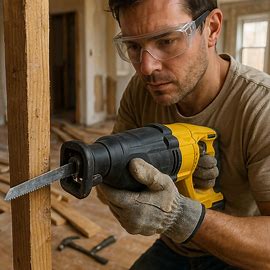Reciprocating saws are total game changers for demolition, renovation, and tough cutting tasks. Whether I’m working on home renovations or tackling outdoor projects, this tool has saved me more time and sweat than I care to count. If you’re new to reciprocating saws, figuring out what to look for and understanding their many uses can be a little confusing at first. I’m breaking down what goes into choosing and using a reciprocating saw, plus practical tips for making the most out of this solid tool—at home or on the job.

What Is a Reciprocating Saw?
A reciprocating saw is basically the rough and ready tool for cutting through just about anything. It uses a push and pull (reciprocating) blade motion, which makes it a top pick for demolition, pruning, and plenty of renovation tasks. Instead of making clean, precise cuts like a circular saw or jigsaw, reciprocating saws are made for fast, aggressive, and often awkward cuts; think pipes, nails, lumber, drywall, or even old window framing. In short, you get lots of cutting power in a pretty compact package.
Reciprocating saws go by a couple of names, depending on where you’re reading. “Sawzall” is actually a trademarked term by Milwaukee Tool, but many folks use it to talk about the general tool. You might also hear people call them “recip saws” or even “hacksaws on steroids.” Whatever the name, their popularity has grown fast in construction, landscaping, and DIY circles for their sheer versatility.
Why Reciprocating Saws Are Popular in Home Renovation

I find reciprocating saws super handy for home renovation jobs because they handle messier, less predictable cuts that other saws just can’t manage. Demo work is their bread and butter: taking out old framing, cutting through pipes behind a wall, ripping out drywall, or trimming rotted sections of wood. Their thin blades fit into spaces that circular or miter saws can’t even touch, so you’re able to make cuts flush against walls or flooring.
- Versatile Cutting: Handles wood, metal, and sometimes even masonry with the right blade.
- Compact Size: Fits into tight spots where bigger saws are totally useless.
- Speed: Demolition goes way faster since you don’t need perfect cuts, just quick and powerful ones.
If you’re renovating an older house or needing to cut out old plumbing lines, there’s really no substitute.
Key Features and Popular Brands
I’ve spent a lot of time with different reciprocating saws. Here are the features that actually matter for most people:
- Variable Speed Trigger: Lets you adjust cutting speed, which is useful when switching between wood, metal, and plastic.
- Orbital Action: Some models offer an orbital cutting setting for faster, rougher jobs in wood. This makes the blade move in an elliptical motion for speedier demolition cuts.
- Tool-Free Blade Change: Makes swapping blades much easier. You’ll find yourself changing blades often for different materials.
- Adjustable Shoe: Extending or angling the saw’s front shoe gives better stability and control during tricky cuts.
- Corded vs Cordless: Corded saws give more power for continuous use, but cordless models allow you to reach awkward or outdoor spots without hassle. For jobs away from outlets or up on ladders, cordless is the way to go.
Some of the brands I keep seeing (and using) are:
- Milwaukee: Honestly the gold standard. Their Sawzall line is known for long life and a heavy duty build.
- Dewalt: Very popular with contractors. They offer reliable options, especially in the cordless XR line.
- Makita: Smooth operation and solid durability. If you’ve already got Makita batteries, their reciprocating saws are worth tracking down.
- Ryobi: Affordable options, especially if you’re mainly doing home projects and want to stick with one battery brand.
Best Uses: Wood, Metal, and More

Reciprocating saws can slice through more materials than you might guess. Here’s a look at what they’re best at:
- Wood: Ideal for framing, demolition, lopping off tree branches, or trimming decking. Use coarse toothed blades for quick, aggressive cuts.
- Metal: With the right fine toothed blade, you can cut steel pipes, sheet metal, nails, or even rebar. Always check the blade label for “bi-metal” or “metal cutting.”
- Plastic & PVC: Works great for slicing through old plumbing pipes or conduit during remodels.
- Drywall and Plaster: Super useful for making quick, rough opening cuts without switching tools. Just use a standard demolition blade.
While you could technically put a masonry blade on some reciprocating saws, I prefer using a rotary tool or angle grinder for brick or ceramic tiles because it’s easier and creates a neater cut.
Types of Blades and How to Choose Them
Blades make all the difference. I always keep a variety around for different jobs. Here’s how I sort them out:
- Wood Cutting Blades: Wide, thick, and have large teeth for fast, rough cuts. Some options even have a “nail embedded wood” label; use these for demolition work when you’re not sure what’s hiding in framing.
- Metal Cutting Blades: Narrower, with smaller teeth (higher TPI, or teeth per inch). Bimetal blades work well for tougher materials, while carbide tipped blades are even better for heavy gauge steel or cast iron pipes.
- Pruning Blades: Longer, extra thick, and made for cutting green or dead tree branches. They resist bending, which really helps when you’re up in a tree.
- Specialty Blades: You can find blades for masonry, fiberglass, and even blades with grit for cutting tile or cement board.
One tip—always match the TPI (teeth per inch) to what you’re cutting. Low TPI (6-10) for wood, 14-24 TPI for metal, and somewhere in between for plastic or mixed-material demolition. Swapping blades is quick, so don’t risk burning out a cheap all purpose blade on stubborn metal or thick lumber.
Reciprocating Saws for Homeowners: How to Choose the Right One

If this is your first time buying a reciprocating saw, here are a few tips I wish I’d known when starting out:
- Budget and Power Needs: If you plan to use it for big demolition jobs, go for corded models with higher amperage (10-15 amps). For occasional use or light renovations, cordless is usually enough (18V is the sweet spot for most brands).
- Weight and Feel: Pick it up before buying if you can. A saw that feels balanced in your hand is a big deal for control and comfort during longer jobs.
- Battery Ecosystem: If you already use, say, Dewalt or Makita cordless tools, sticking to the same brand lets you share batteries—pretty handy and helps cut costs.
- Warranty and Support: Milwaukee, Dewalt, and Makita all offer solid support and spare parts if something breaks.
- Included Blades: Most saws include a basic starter blade. Grab a multipack of good quality blades matched to your most common materials for far better results. Try to keep both wood and metal cutting blades handy.
What Can Go Wrong? Common Mistakes and Fixes
Reciprocating saws are tough, but things can still go sideways. I’ve seen plenty of people, including myself, face these snags:
- Blade Pinching: If the cut pinches the blade, it can bend or stall the saw. Take your time and cut in short bursts, letting the blade do the work.
- Wrong Blade: Using the incorrect blade will either destroy it quickly or mess up what you’re cutting. Always double check your blade before starting.
- Not Wearing Safety Gear: Goggles and gloves aren’t just for safety shows. Flying debris, sparks, and hot metal shavings can cause real injuries, so gear up every time.
- Battery Drain: Cordless models go through batteries quickly on big jobs. Keeping spare charged batteries nearby helps you keep the project moving.
FAQs About Reciprocating Saws
What’s the difference between a corded and cordless reciprocating saw?
Corded saws give you more continuous power and are better for heavy-duty demolition, while cordless models offer better portability and are easier to use up a ladder or away from outlets.
Which brands are reliable if I’m just a DIYer?
Ryobi and Black+Decker give you plenty of power for most home projects at a good price. If you already use tools from another brand, like Makita or Dewalt, their reciprocating saws are a great step up, especially if you’ll be using it a lot.
What type of blade do I need for metal?
Bimetal blades with a high teeth per inch count (14-24 TPI) are best for steel, aluminum, and copper. For the thickest materials, use carbide tipped blades.
Can a reciprocating saw be used for pruning trees?
Absolutely! Just use a pruning blade. These are longer and thicker, built for green wood, and way faster than manual loppers for big branches.
Wrapping Up
Reciprocating saws have earned their spot in my toolbox for a reason. From home renovation and demolition to weekend landscaping, they bring speed and versatility to almost any cutting job. Picking the right blades and a saw that fits your needs gets you far. Safety gear, the right blade swaps, and a little practice help you handle just about any material in your path.
If you’re planning to take on home renovations or any major outdoor cutting, this tool is worth having in your lineup for years to come.
